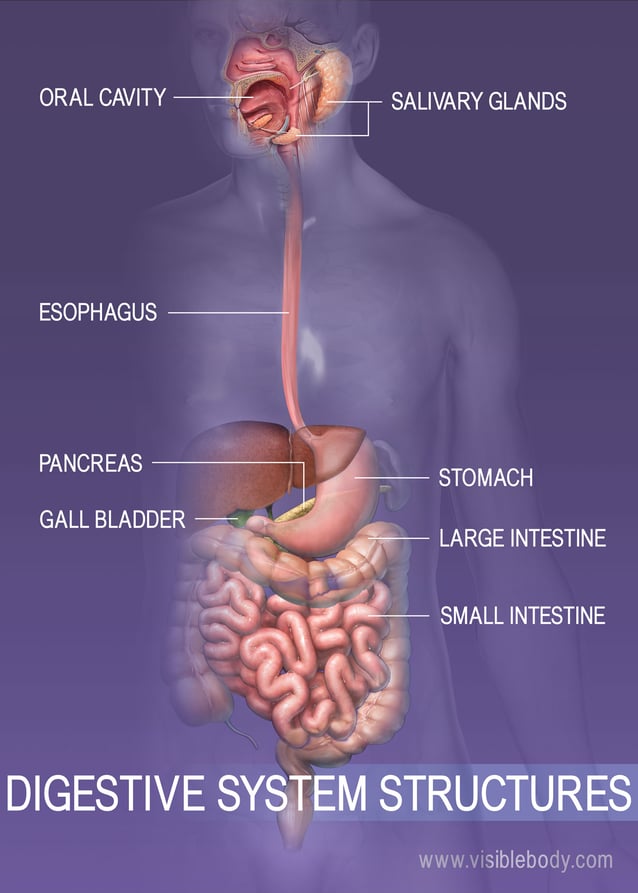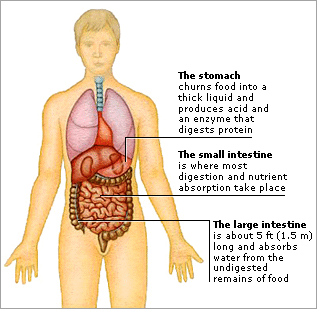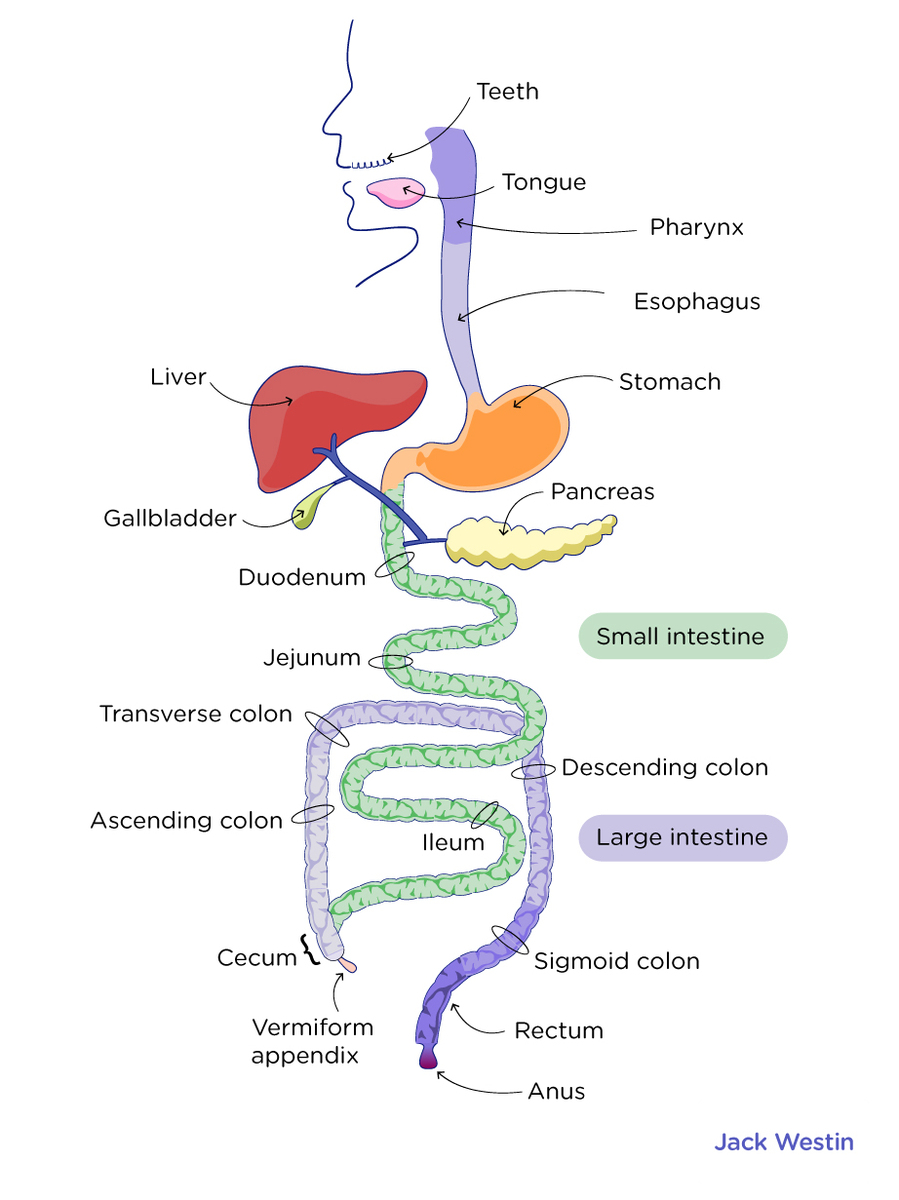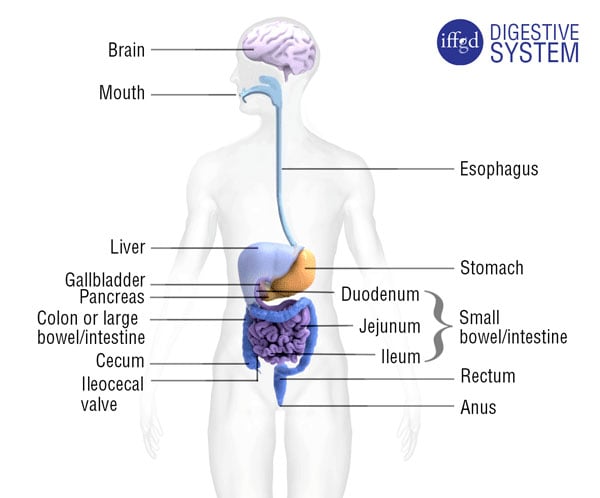A number of secretions and the activity of a variety of enzymes starting from the mouth till the intestines are involved in this process. Fat soluble vitamins are absorbed in the same manner as lipids.

In Which Part Of The Digestive System Is Water Absorbed Youtube

10 Facts About The Digestive System

Dk Human Body Digestion
The GI tract is one part of the digestive system.

Where is the water absorbed in the digestive system. The digestive system of the human body is the sum of the gastrointestinal tract GIT. The digestive system is made up of the digestive tract and other organs that help the body break down and absorb food. Check out our Patreon page.
Water-soluble vitamins can be directly absorbed into the bloodstream from the intestine. One of the livers primary functions is to regulate metabolic homeostasis. Digestive systems take many forms.
Water soluble nutrients absorbed into the blood travel directly to the liver via a major blood vessel called the portal vein. The omasum has many folds of tissue similar to a partially open book and contains from 6 to 8 percent of the total digestive tract capacity. The organs that make up the GI tract are the mouth throat esophagus stomach small intestine large intestine rectum and anus.
The nutrients in food are used by the body as fuel to keep all the body systems working. When you go to the bathroom you get rid of this solid waste by pushing it through the anus. The cephalic phase the gastric phase and the.
The gastrointestinal GI tract is a collection of organs that allow for food to be swallowed digested absorbed and removed from the body. SlideShare uses cookies to improve functionality and performance and to provide you with relevant advertising. Water-soluble vitamins can be directly.
When its functioning properly the digestive system helps the body get the nutrients and energy it needs. Respiration is the creation of energy by using glucose sugar and oxygen. Parts of the nervous and circulatory systems also play roles in the digestive process.
The organs of the digestive system work together so that complex biomolecules in food are broken down into their simple monomers and absorbed by the body. Introduction to the Digestive System. The digestive system of a chicken mechanically and chemically breaks down food in different stages and allows nutrients to be absorbed readily for use in the body.
People are probably more aware of their digestive system than of any other system not least because of its frequent messages. Together a combination of nerves hormones bacteria blood and the organs of the digestive system. But problems can occur in the digestive system.
This dehydration combined with. The digestive system helps the body digest food. The digestive system includes the digestive tract and its accessory organs which process food into molecules that can be absorbed and utilized by the cells of the body.
The Digestive System Prepares food for use by all body cells. These are waste products and the body gets rid of them. Respiratory system Digestive system Respiration takes place in the cells.
The omasum is thought to aid in the reabsorption of water form digesta flowing through it and to assist in reducing particle size. In this process enzymes are secreted into the environment surrounding the organism where they break down an organic material and some of the products diffuse back to the. The digestive system is the group of organs that break down food in order to absorb its nutrients.
This process begins in the small intestine where most of the nutrients and minerals are absorbed. The process of enzymes breaking down food into small molecules the body can use. A semiliquid mass of partially digested food that passes from the stomach through the pyloric sphincter into the duodenum.
The human digestive system consists of the gastrointestinal tract plus the accessory organs of digestion the tongue salivary glands pancreas liver and gallbladder. The inside of the large intestine is wider than the small intestine. It is important to consume some amount of dietary lipid to aid the absorption of lipid-soluble vitamins.
External digestion developed earlier in evolutionary history and most fungi still rely on it. Digestion involves the breakdown of food into smaller and smaller components until they can be absorbed and assimilated into the body. Some water are absorbed as peristaltic waves move the chyme into the ascending and transverse colons.
If you continue browsing the site you agree to the use of cookies on this website. The process of digestion has three stages. The excess water in the indigestible matter is absorbed by the large intestines.
Fat-soluble vitamins are absorbed in the same manner as lipids. It starts at the beak and ends at the vent or Cloaca to give it its proper name. The last section of the digestive system where water is absorbed from food and the remaining material is eliminated from the body.
The last part of the digestive system is the anus AY-nus. Also called alimentary canal and accessory organs tongue liver pancreas. It is a long twisting tube that starts at the mouth and goes through the oesophagus stomach small intestine large intestine and anus.
When the digestive system has broken down food to its nutrient components the body eagerly awaits delivery. The absorbed materials cross the mucosa into the blood mainly and are carried off in the bloodstream to other parts of the body for storage or further chemical change. Bacteria in the GI tract also called gut lora or microbiome help with digestion.
Bacteria in the large intestine also help with the final stages of digestion. Vitamins can be either water-soluble or lipid-soluble. The leftover parts of food that cannot be broken down digested or absorbed are excreted as bowel movements stool.
Foods Journey Through the Digestive System Stop 1. After sufficient time in the reticulo-rumen digesta flows into the omasum. The digestive tract also called the alimentary canal or.
A Childs Digestive System. When the energy is created you also get carbon dioxide and water. Enzymes in the pancreatic juices that break down lipids.
Once chyme has been in the large intestine for 3-10 hours it becomes semi-solid. Digested molecules of food as well as water and minerals from the diet are absorbed from the cavity of the upper small intestine. Digestive System vocabulary game to match the names with the picture.
It does not contain villi and mainly absorbs water. Food is broken down bit by bit until the molecules are small enough to be absorbed and the waste products are eliminated. The Mouth The mouth is the beginning of the digestive system and in fact digestion starts here before you even take the first bite of a meal.
Help your digestive system stay healthy by drinking lots of water and eating a healthy diet. Digestive System Function Breaking Down Food. There is a fundamental distinction between internal and external digestion.

Water And Hydration Physiological Basis In Adults Hydration For Health

Small Intestine Digestive System Mcat Content

Digestive System Bioninja

Difference Between Digestion And Absorption Compare The Difference Between Similar Terms

The Digestive System Iffgd
/digestive-system-56a13acb3df78cf772688fab.jpg)
What Is The Digestive System

How Undigested Food Changes In The Digestive System
How Long Does It Take For Water To Reach The Intestine After We Drink It Quora
